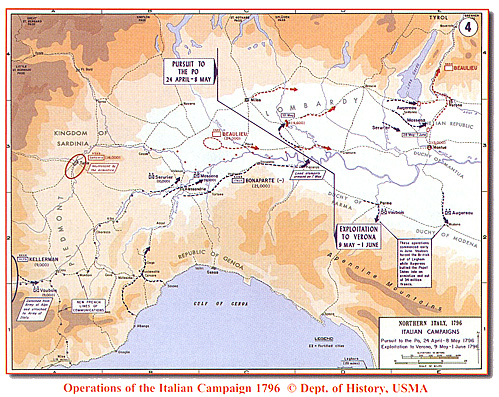The “Surprise of Brescia”
1796
Offensive de Wurmser,
Castiglione (pp. 283-288)
by Bernard Voykowitsch, Austria
| |
The period that extends until the end of July doesn’t present any particular interest as regards the cavalry. The French were occupied by the sieges of the Milan citadel and of the fortress of Mantua and by the expeditions to Modena, Bologna and Livorno. The offensive of Wurmser who had replaced Beaulieu and had received considerable reinforcements was to end up in new and glorious operations. 29 July the situation of the Armee d’Italie was as follows: Massena’s division occupied the terrain from Lake Garda until San Giovanni on the Adige downstream Verona; his left was at Rivoli. The division had the 25e Chasseurs and the 15e Dragons under the command of Gneral Beaumont which furnished reconnaissance daily. Sauret’s division watched the terrain from Lake Iseo until Lake Garda or the route from Riva to Brescia by Lodrone and Nozza. She had at Brescia one sqn of the 5e Dragons and 80 men of the 24e Chasseurs (Correspondence of Napoleon No .794. 100 horse (Cpt Barbier) says the Regimental History of the 24e Chasseurs, which were surprised at Brescia 30 July. The rest of the 24e Chasseurs were with army headquarters.) Augereau’s division along the Adige from Zevio to Castagnaro had placed the 22e Chasseurs at Legnago. 100 to 200 cavalry detached by Kilmaine had to cover the right and patrol the far side of the Adige and of Badia. Despinoy’s division at Peschiera, San Giovanni and Zevio. Serurier’s division ran the siege of Man-tua. She disposed of the 8e Dragons and the 7e bis Hussards. Kilmaine’s cavalry division with the 10e Chasseurs, 1er Hussards, 20e Dragons and two squadrons of the 5e Dragons and 12 guns was at Vallese behind the curtain of infantry divisions. “She observes all the movements that the enemy could make on the Adige and ist commander will make the dispositions which he judges convenient”. The total of troops on horseback was 3,000 of which 2,000 with Kilmaine. All the depots of the cavalry had been concentrated at Milan under the orders of General Beaurevoir. 9 June they comprised 300 dismounted of different regiments for whom one tried to provide horses. The events would show the value of these dispositions. Debouching at the same time on both sides of the Adige and by paths which revealed the “most minutious knowledge of the communications of the country” the Austrian columns surprised on the same day the French outposts at la Corona and Salo and took Rivoli and Brescia. Such bad was Bonaparte wrote to Augereau the situation of the army ... You see that our communications are cut with both Milan and Verona.” Neither at Rivoli where were the 15e Dragons, nor at Brescia where the detachment of the 24e Chasseurs had itself surprised and captured in its quarters the cavalry played any role nor did it announce the approach of the Austrians which numerous signs had indicated to be in the offing. The glorious victories of Lonato and Castiglione saved the army but some typical examples may show the few services the French cavalry rendered even regarding local security: During 3 August while Massena prepared to attack Lonato his advance guard (4e Legere and carabiniers of the 11e Legere) was enveloped. GB Pijon and a considerable number of prisoners and two pieces fell into the hands of the Austrians. The 15e Dragons arrived from the road of Ponte San Marco and charged and drove back five troops of Austrian Ulans. Once Lonato had been retaken Junot with 25 guides and the 15e Dragons charged 200 Austrian hussars who to the north of Desenzano escorted back the prisoners made from the French advance guard in the morning. Yet attacked by Ulans before they had reformed the French dragoons were defeated and withdrew to Desenzano loosing 6 killed, 12 wounded among whom Junot and two other officers and 35 prisoners. Also with Augereau’s division an Austrian surprise attack took place in the evening of 3 August which cost the life to the chef de brigade of the 1er Hussards, Bougon-Duclos. “Night falling, wrote Augereau, exactly at the time when I was making the dispositions for the next day, 200 Austrian hussars showed up in our rear and came as close as a pistol shot to Castiglione; immediately the whole artillery park routed and sewed terror into the souls of the soldiers who fled at the run. Luckily we have been able to rally some of them in order to guard us. ... The cavalry has suffered a lot considering its small number. ...” On 4 August, after Lonato, Bonaparte only narrowly failed to be captured by an Austrian column coming from San Marco and debauching into the rear of Massena’s division.
Operations of the Italian Campaign 1796 © Dept. of History, USMA The “Surprise of Brescia” 1796
“The Surprise Attack of Brescia on 30 July 1796” Offensive de Wurmser, Castiglione (pp. 283-288) The Pursuit after Castiglione Back to Table of Contents -- First Empire # 75 Back to First Empire List of Issues Back to MagWeb Master Magazine List © Copyright 2004 by First Empire. This article appears in MagWeb.com (Magazine Web) on the Internet World Wide Web. Other articles from military history and related magazines are available at http://www.magweb.com |
